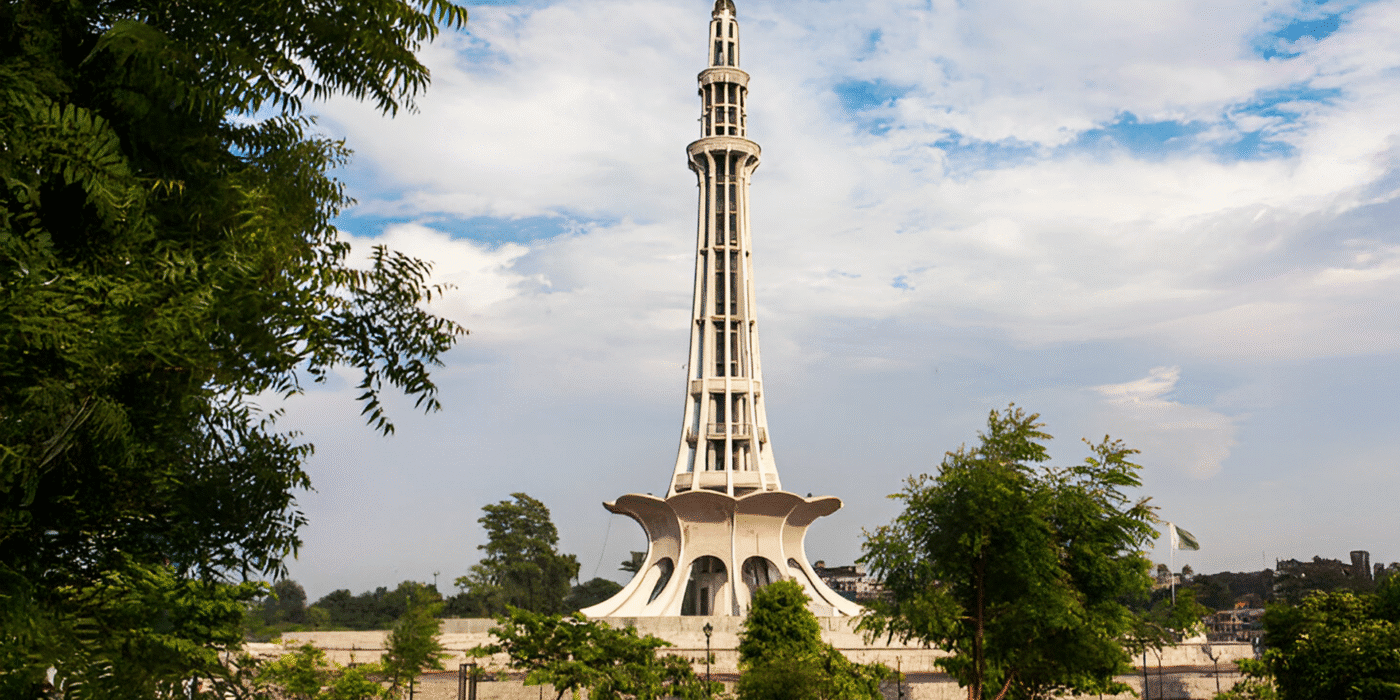Rising majestically in the heart of Lahore, Minar-e-Pakistan is a symbol of the nation’s identity and historical struggle, it continues to captivate visitors with its towering presence and cultural significance. From its impressive architecture to its role in shaping Pakistan’s history, Minar-e-Pakistan stands as a landmark worth exploring. Keep reading to discover its history, design, symbolism, and tourist appeal.
Minar-e-Pakistan History
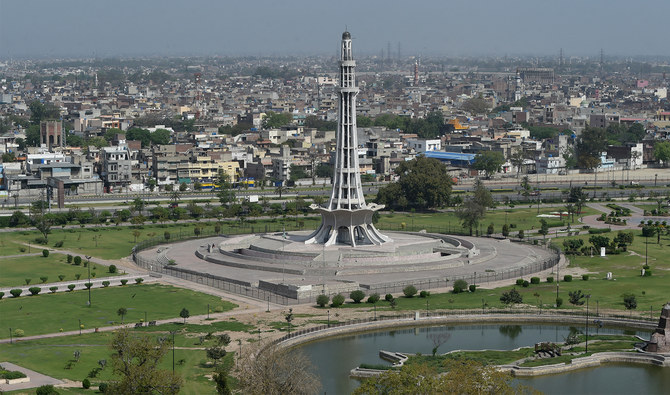
The Minar-e-Pakistan is one of the most iconic landmarks in Lahore, representing the country’s struggle for independence and national identity.
The monument stands on the site where the All-India Muslim League passed the Lahore Resolution on March 23, 1940, demanding a separate homeland for Muslims in the Indian subcontinent.
This pivotal resolution eventually led to the creation of Pakistan in 1947, making the site historically and politically significant.
Mughal and Colonial Context
Although the monument was constructed in the 1960s, the site itself holds centuries of historical and cultural significance, linking Lahore’s rich Mughal heritage with Pakistan’s modern national identity. It reflects the architectural and cultural continuity of the region:
- Lahore, as a Mughal stronghold, was historically a center for religious, political, and cultural developments.
- The monument’s location near Greater Iqbal Park and Lahore Fort ties it to a lineage of imperial and civic landmarks.
- Minar-e-Pakistan symbolizes the struggle, aspirations, and sacrifices of Muslims during the Pakistan Movement, serving as a constant reminder of the nation’s founding ideals.
Construction and Design Leadership
- The monument was designed by Nasreddin Murat-Khan, a renowned architect, blending Islamic, Mughal, and modern design elements.
- Construction took place between 1960 and 1968, employing reinforced concrete, marble, and stone to ensure both durability and aesthetic appeal.
- The design incorporates symbolic elements representing the phases of the independence movement:
- Base platforms: Represent humble beginnings and the early struggles of Muslims in the subcontinent.
- Intermediate platforms: Depict the movement’s growing momentum and determination.
- Upper polished marble platform: Signifies the ultimate success and achievement of Pakistan’s independence.
Political and Cultural Role
Over the decades, Minar-e-Pakistan has been more than a historical monument; it has become a vibrant civic and cultural symbol:
- Hosts national celebrations, including Pakistan Day (March 23) ceremonies.
- Venue for political rallies, cultural events, and public gatherings, reflecting its ongoing relevance in national life.
- Acts as a symbol of unity, pride, and historical continuity, connecting modern Pakistanis to their heritage.
Through its rich history, symbolic design, and enduring cultural presence, Minar-e-Pakistan stands as both a monument to the past and a beacon of national identity, drawing visitors, historians, and citizens alike to reflect on Pakistan’s journey.
Architecture and Design
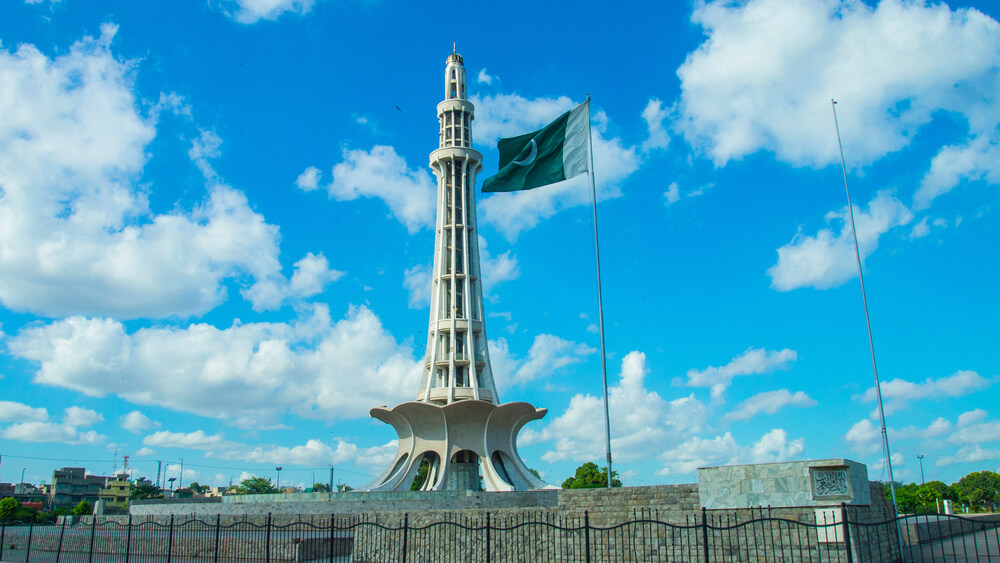
The architecture of Minar-e-Pakistan is a remarkable fusion of Islamic, Mughal, and modern styles, reflecting both the heritage of the region and the aspirations of a new nation.
Designed not only as a monumental structure but also as a symbol of the Pakistan Movement, it balances grand scale with intricate symbolic storytelling, making it one of Lahore’s most iconic landmarks.
Base and Symbolic Platforms
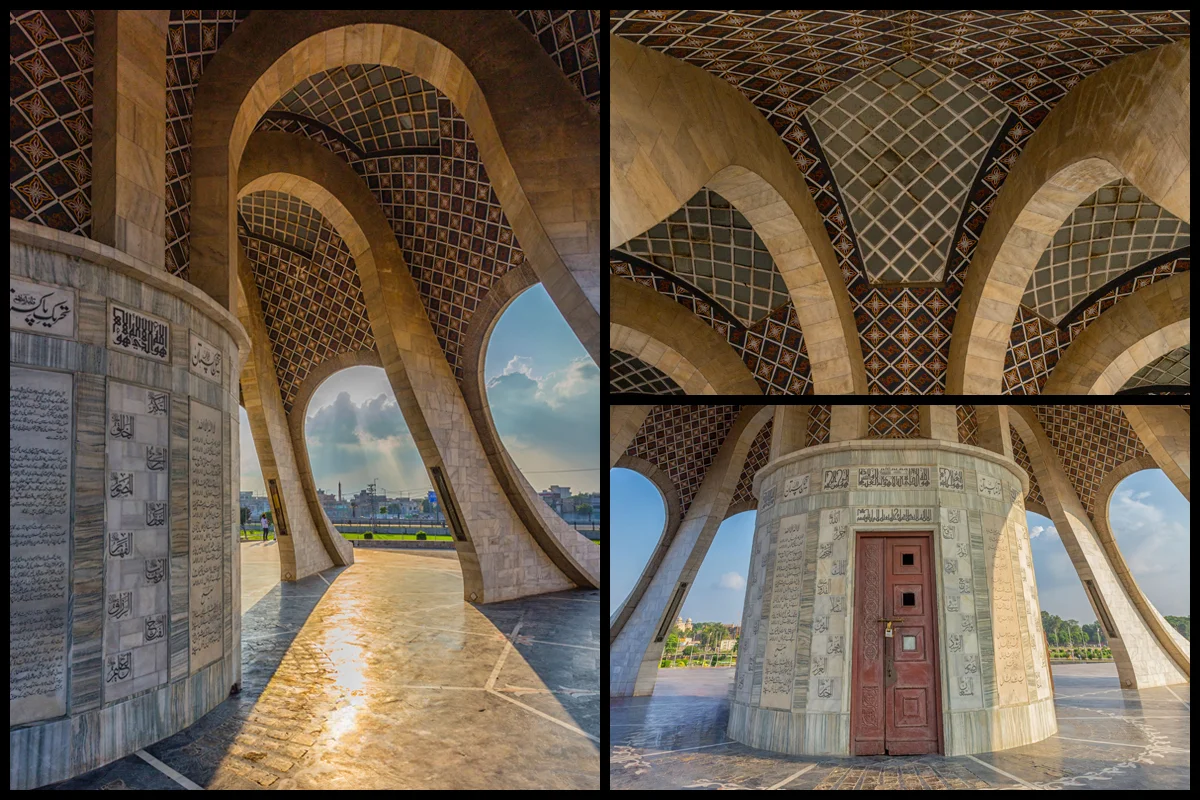
The base of Minar-e-Pakistan is uniquely shaped like an eight-petal flower, symbolizing growth, prosperity, and the unfolding of a new nation. Minar-e-Pakistan has a total of eight floors that visitors can access via stairs or a lift. The monument is built on four symbolic platforms, each representing a stage in the struggle for independence:
- Uncut Stones from Taxila – represent the humble beginnings and initial struggles of the Pakistan Movement.
- Hammer-Dressed Stones – signify the challenges and hardships faced by the movement.
- Chiseled Stones – depict the momentum gained as the struggle progressed.
- Polished White Marble – symbolizes the success and establishment of Pakistan, representing purity, achievement, and national pride.
These platforms not only enhance the monument’s symbolic meaning but also guide visitors through a visual narrative of Pakistan’s independence journey.
Materials and Craftsmanship
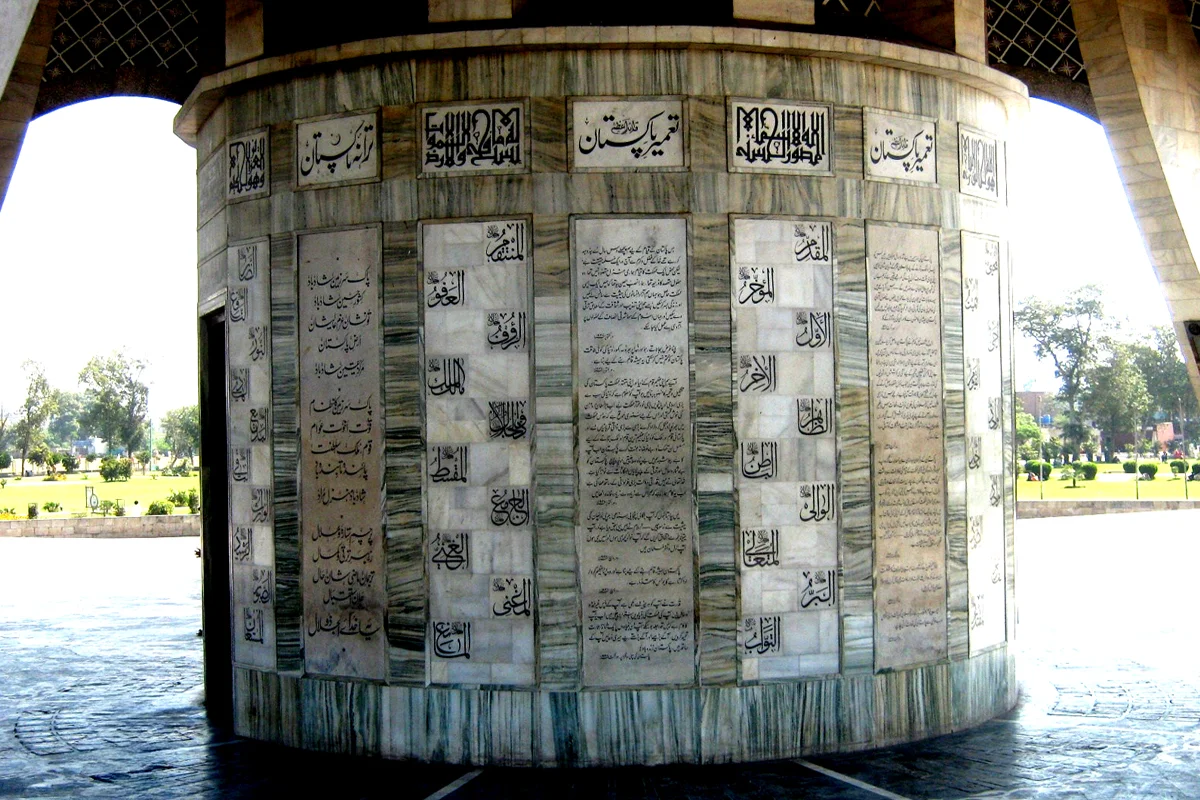
Minar-e-Pakistan is constructed using reinforced concrete to ensure structural stability and longevity. The monument is finished with marble and stone, giving it a timeless aesthetic appeal while protecting it from weathering.
- Inscriptions: The walls feature intricate calligraphy and inscriptions in Urdu, Bengali, and English. These include:
- Excerpts from speeches by Muhammad Ali Jinnah and Allama Iqbal.
- Verses from the Qur’an, emphasizing spiritual and cultural heritage.
- Portions of the national anthem, reinforcing its patriotic significance.
The combination of materials and craftsmanship ensures that Minar-e-Pakistan is not only visually stunning but also a durable symbol of national pride.
Structural Features
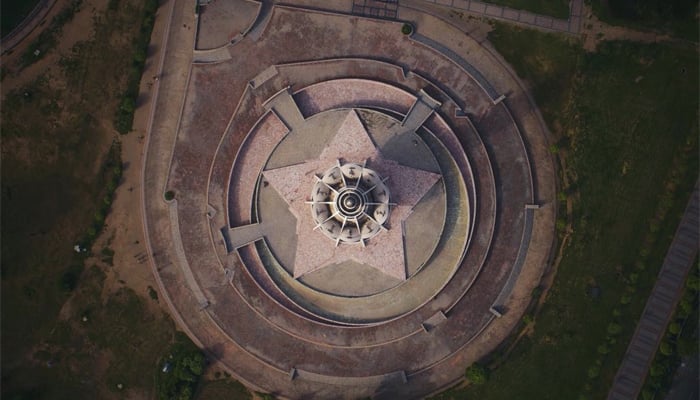
- Height: Standing at 70 meters, the minar dominates Lahore’s skyline and is visible from across Greater Iqbal Park.
- Design Elements: A harmonious blend of curved, geometric, and floral motifs reflects both Mughal influences and modern architectural principles.
- Platforms and Terraces: Visitors can explore multiple levels, offering panoramic views of the surrounding park, Badshahi Mosque, and Lahore Fort, allowing them to fully appreciate the monument’s scale and artistry.
The architecture of Minar-e-Pakistan goes beyond aesthetics; it serves as a symbolic and functional landmark, blending history, culture, and engineering ingenuity in one monumental structure.
Cultural and Political Significance
The Minar-e-Pakistan is not just an architectural marvel; it stands as a living symbol of Pakistan’s identity, history, and aspirations. Beyond its structural beauty, the monument embodies the struggle, vision, and unity that led to the creation of Pakistan.
Historical Importance
- The minar marks the exact site where the All-India Muslim League passed the Lahore Resolution on March 23, 1940, demanding a separate homeland for Muslims.
- This historic event was pivotal for Pakistan’s independence in 1947, making the monument a physical reminder of the nation’s foundation.
Role in National Celebrations
- The monument serves as the primary venue for Pakistan Day celebrations, attracting thousands of citizens and officials each year.
- It hosts political rallies, cultural festivals, and public gatherings, reinforcing its status as a center of civic and national life.
- During special occasions, the surrounding Greater Iqbal Park becomes a hub for patriotic events and communal activities.
Symbol of Unity and National Pride
- Minar-e-Pakistan represents the resilience, determination, and aspirations of the Muslim community in the subcontinent.
- Its design, inscriptions, and symbolic platforms remind citizens and visitors of the sacrifices made during the Pakistan Movement.
- As a cultural landmark, it continues to inspire national pride, historical awareness, and civic responsibility.
Through its historical context, ceremonial role, and symbolic meaning, Minar-e-Pakistan remains one of Pakistan’s most significant cultural and political icons, bridging past struggles with contemporary national identity.
Tourism and Visitor Information
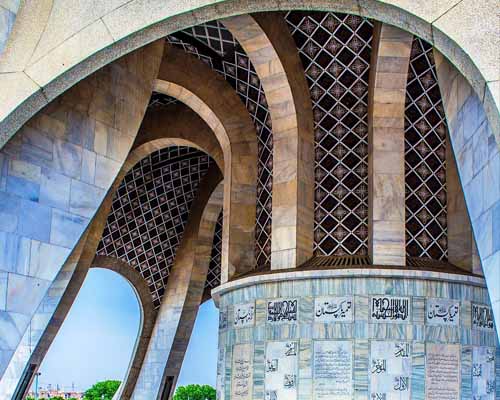
The Minar-e-Pakistan is one of Lahore’s most iconic landmarks, attracting a diverse range of visitors including local residents, students, history enthusiasts, and international tourists. Its towering presence, cultural significance, and beautiful surroundings make it a must-visit destination in the city.
Location and Accessibility
- Situated in the heart of Greater Iqbal Park, Lahore, the monument is surrounded by lush green spaces, walking trails, and recreational areas.
- Easily reachable via public transport, taxis, or private vehicles, with ample parking facilities nearby.
- Well-connected to major roads and pedestrian pathways, making it accessible for both casual visitors and organized tour groups.
Best Time to Visit
- Early Morning: Ideal for a quiet and reflective experience, with cooler temperatures and minimal crowds.
- Sunset: Perfect for photography, as the red sandstone and marble façade glows under natural light, creating stunning visual effects.
Nearby Attractions
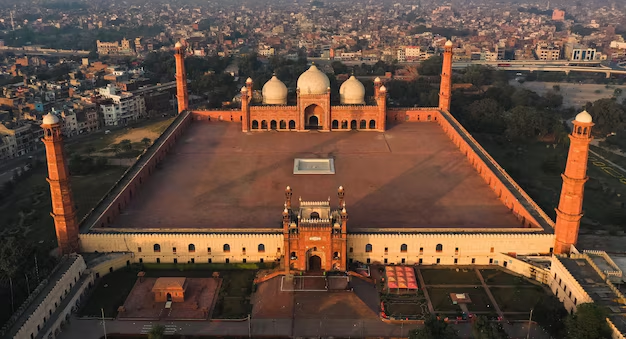
Visiting Minar-e-Pakistan can be combined with several historical and cultural landmarks in Lahore:
- Badshahi Mosque – a majestic Mughal-era mosque located adjacent to the park.
- Lahore Fort – a UNESCO World Heritage site, offering historical insights and architectural splendor.
- Fort Road Food Street – experience authentic Lahori cuisine with spectacular views of the monument.
Mughal Construction Legacy
Although constructed in the 1960s, Minar-e-Pakistan draws significant inspiration from Mughal architectural principles, reflecting the grandeur, symmetry, and decorative excellence characteristic of the empire. Its design demonstrates how historical architectural styles can be adapted into modern national monuments while preserving symbolic significance.
Key Architectural Features Inspired by the Mughals
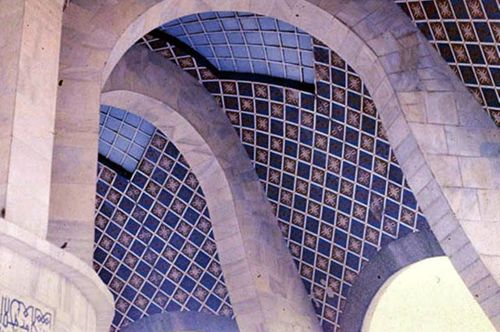
- Grand Scale and Monumental Presence: The towering height of 70 meters and the expansive base create a sense of dominance and visual impact, typical of Mughal monumental structures.
- Symmetry and Balance: The minar’s layout maintains perfect proportionality and geometric harmony, echoing the Mughal emphasis on balanced and orderly design.
- Decorative Detailing: Features such as floral motifs, geometric patterns, and intricate inscriptions reflect Mughal artistry and Islamic design sensibilities.
Influence on Later Structures
- Minar-e-Pakistan has inspired design elements in subsequent Pakistani national monuments, incorporating similar symmetry, vertical prominence, and decorative inlays.
- Its planning of platforms, terraces, and landscaped surroundings has set benchmarks for modern civic and public architecture, demonstrating effective integration of aesthetic appeal and functional accessibility.
- The monument represents the continuity of Islamic and Mughal architectural principles in contemporary Pakistani civic design, bridging historical heritage with modern symbolism.
Conservation Efforts
To preserve its historical, cultural, and structural significance, Minar-e-Pakistan has undergone several restoration and maintenance initiatives over the decades.
UNESCO Recognition
Added to the UNESCO Tentative List in 1993, acknowledging its global cultural and historical importance.
Restoration and Maintenance Programs
- Managed by Punjab heritage authorities, these programs ensure that the monument remains structurally sound and visually intact for visitors.
- Restoration focuses on:
- Preserving intricate marble inlays and inscriptions, including Quranic verses and historic speeches.
- Maintaining the stability of platforms, terraces, and the base, ensuring safety for visitors.
- Enhancing accessibility for tourists, including ramps and designated pathways, without compromising the monument’s aesthetics.
Through these efforts, Minar-e-Pakistan continues to stand as a symbol of national pride, blending historical architectural inspiration with modern preservation techniques. It remains a living monument, educating and inspiring visitors while safeguarding Pakistan’s rich cultural heritage.
For more information on similar content like Symbolism in design, visit Chakor blogs.
FAQs
What’s Minar-e-Pakistan Timing?
Minar-e-Pakistan is typically open from 8:00 AM to 10:00 PM daily for visitors.
Where is Minar-e-Pakistan Located?
Minar-e-Pakistan is located in Greater Iqbal Park, Lahore, Pakistan.
When was Minar-e-Pakistan Built?
Construction of Minar-e-Pakistan began in 1960 and was completed in 1968.
How Many Floors of Minar-e-Pakistan are There?
The monument consists of four symbolic platforms, each representing different phases of the independence movement.
What’s Minar-e-Pakistan Park Name?
Minar-e-Pakistan is situated within Greater Iqbal Park, one of Lahore’s largest urban parks.
Who Built Minar-e-Pakistan?
Minar-e-Pakistan was constructed by the Pakistani government under the supervision of architect Nasreddin Murat-Khan.
Height of Minar-e-Pakistan in Feet?
The height of Minar-e-Pakistan is approximately 230 feet (70 meters).
Architect of Minar-e-Pakistan?
The architect of Minar-e-Pakistan was Nasreddin Murat-Khan, who designed the monument to symbolize Pakistan’s independence.

